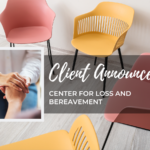What’s on the mind of top nonprofit leaders at this strange point in time, as we look back on a full year of a pandemic and ahead to a future still decidedly uncertain? We had the chance to find out during our latest Leadership Matters webinar. The discussion brought together four exceptionally capable and visionary CEOs representing varied sectors of the nonprofit world:
- Joyce Ajlouny, General Secretary of the American Friends Service Committee, a Quaker organization, founded in 1917, focusing on such issues ranging from international peacebuilding to immigrant rights and economic justice.
- Michael Hill, President of the Chautauqua Institution, an organization dedicated to educational, artistic, and religious exploration which draws more than 100,000 attendees to its summer events each year.
- Gabrielle Webster, President and CEO of Boys & Girls Clubs of Greater Washington, an organization serving more than 20,000 young people annually at 16 regional sites.
- Tonia Wellons, President and CEO of the Greater Washington Community Foundation, a champion of thriving communities and catalyst for change through local philanthropy since 1973.
Each of these organizations rose to the challenge of the past year in admirable ways, and each leader shared fascinating insights on how they did it. To find out for yourself, check out our roundtable exchange here.
Do so and you will hear about one organization and the year-long “journey of deep listening” that helped ensure it was positioned to meet the ever-changing needs of the moment—led by a CEO who has yet to meet her staff in person since becoming president because she took the job just as work went remote. You will learn about an NGO whose experience operating in dangerous international hotspots proved all too relevant as life was disrupted closer to home. You will hear the story of a 150 year-old tradition-rich cultural institution that found itself fulfilling its plan to “go digital” in the space of weeks rather than years—and with phenomenal results. And you will hear about an organization that has long made a difference in the lives of young people of color, but following the events of the last year has now seen the need to lead in bolder and more visible ways on issues of social and racial justice.
Related to this last point, you will, in fact, hear all these leaders speak of a year that challenged us with not a single crisis, but several: one viral, one racial, and one economic. (Tonia Wellons aptly termed the combination “a trifecta.”)
The discussion provided ample food for thought—in fact a feast. So I’ll need to be selective in sharing my take-aways.
The first concerns the nature of effective leadership in difficult times. The crisis presented the four CEOs with tremendously difficult decisions and challenges: How to manage staff members, while “managing up” as well, to keep Board members engaged and aligned? How to balance business-based necessities with mission-driven commitments? How to be sensitive to the needs of you employees, while placing enormous demands on them in order to maintain critical services?
Michael Hill’s experience at Chautauqua encapsulates many of these challenges. The decision to cancel the Institution’s summer season of programming for the first time in a century-and-a-half meant disappointing 100,000 people who planned to attend, instantly developing online programming to re-engage them, calling on his full-time staff to work miracles in order to make that happen, and being forced to lay off seasonal workers—a painful blow to the fragile local economy.
Each of the CEOs also described the extraordinary stresses the crisis placed on their staff. They spoke of 12- and 14-hour workdays, of senior leadership team meetings seven days a week for months, of staff called upon to meet all-new challenges. At Boys & Girls Clubs of Greater Washington, for instance, clubhouses closed to regular members for obvious public health reasons, but were then asked to reopen to care for the children of essential workers. For 13-hour days, facing then-unknown risks, staff members did just that.
The question is how to inspire that kind of commitment. In our discussion, I heard two answers. The first is simply by example. For every hour every staff member went above and beyond, these CEOs and their senior people were doing the same or more. The second answer is through a deep commitment to mission. Those Boys & Girls Club staffers stepped up in such a courageous way because their mission is to care for kids, and that’s what the moment demanded.
Organizations that live their mission with real intention in ordinary times are fired with a sense of purpose that helps sustain when days of crisis come. Leaders of those organizations are fortunate. They are in a position to ask—and get— truly remarkable things from their people.
The second point I’d like to share relates to fundraising and the donor loyalty that all four CEOs were fortunate to experience during this financially stressful year. All reported gift income that either remained steady or grew. The question to consider is why. The answer, I firmly believe, lies in stewardship. I’m not sure any of the four leaders actually mentioned this term during our webinar, yet all described it in action. Consider this comment from Joyce Ajlouny, of the American Friends Service Committee:
“Our donors deeply identify with our values. So throughout the pandemic, the
economic downturn, and the focus on racial justice, they deepened their
commitment—and we did a good job communicating with them and telling them
what we were doing.”
Joyce really said it all here. A deep connection between donors and the values of AFSC, developed over years, positioned the organization for continued philanthropic support during the crisis. As Joyce summed it up, “In many ways, AFSC was built for this moment.”
The lesson, of course, is to practice consistent, careful stewardship (doing a “good job communicating”) when times are good, to build the resilience and fundamentally strong relationships you will need should they suddenly turn bad.
The last point I would like to share concerns all four CEOs’ striking determination to emerge from this demanding moment fully focused on what lies ahead. As Michael Hill put it, “You have to manage for today, but work for the future—and come out of this roaring.” Tonia Wellons described a process of strategic planning underway at the Greater Washington Community Foundation this way: “We have to look back at what worked and what might not have so we can be really thoughtful with our forward-looking agenda.” And as Gabrielle Webster said,
“I’ve challenged my team to ask what’s next? What are we going to do after this
better than we did coming into it? Because we have had to learn some things. If
we just go back to what used to be normal again, then I frankly think we’ve failed
ourselves. And we’ve certainly failed our young people. We have to and will
come out of this stronger.”
Of course, this is entirely correct. As many have said, the Chinese ideograph for the word “crisis” is actually composed of two parts: the character for danger and the character for opportunity. If we as leaders face the danger, but fail to seize the opportunity, we’ve only done half our jobs. So, yes, our impulse may be to crave a return to a pre-pandemic past. It might be to rest and recover—and that is essential. But it is also now incumbent upon nonprofit leaders to plan and strategize, to sustain the momentum for change gained over the past year, and to explore new ways of delivering on their missions and increasing their impact.



